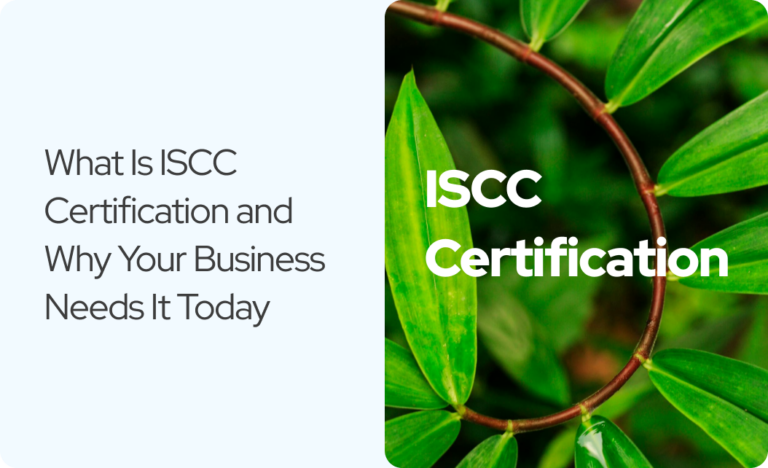Why Automating ISCC Mass Balance Bookkeeping Should Be Part of Your Digital Transformation Strategy

Digital transformation isn’t a buzzword anymore, it’s a survival strategy. For chemical manufacturers, staying competitive means moving faster, working smarter, and proving sustainability with precision.
But there’s one process that’s still dragging many companies down: manual ISCC mass balance bookkeeping.
Still using spreadsheets to track sustainability credits? That’s not digital transformation, it’s digital duct tape.
Manual Mass Balance Bookkeeping: The Hidden Bottleneck
On the surface, spreadsheets seem harmless. But under pressure, especially when audits or customer requests come in, they buckle.
Wondering why mass balance bookkeeping is slowing you down?
Here’s what manual mass balance is really doing:
- Wasting your team’s time: Skilled people are buried in data entry and error checks instead of improving sustainability performance.
- Introducing high-risk errors: One misplaced decimal can trigger a chain reaction of non-compliance, over-allocation, and failed audits.
- Limiting growth: As sites, products, and transactions increase, spreadsheet chaos grows exponentially.
- Fragmenting your data: Isolated files make it impossible to link ISCC data with procurement, inventory, or sustainability KPIs.
- Causing audit panic: Most teams scramble the week before an audit. That’s not a process, it’s a liability.
Why ISCC Automation Powers Real Digital Transformation
Automating ISCC mass balance bookkeeping is more than a compliance upgrade, it’s a strategic enabler.
It supports how you work, how you scale, and how you prove sustainability in real-time.
- Enable data-driven decisions: With clean, consistent data, you unlock AI, analytics, and automation across the business.
- Break down silos: Modern ISCC tools integrate with ERP, MES, and procurement systems, syncing compliance with core operations.
- Standardize your workflows: Automate the logic behind credit tracking, allocation, and declarations—no more guesswork.
- Build cultural buy-in for digital: Show what automation really delivers: fewer errors, faster reporting, happier teams.
What You Gain: Real Numbers, Not Just Buzzwords
- Cut time spent on bookkeeping by 60–80%
(That’s not theoretical—our clients confirm it.) - Reduce over-allocation and audit errors to near zero
- Track sustainability across sites without hiring more compliance staff
- Be audit-ready all year, not just in the final week
- Act faster on supply chain opportunities with live data
Thinking about how to automate ISCC mass balance without changing all your systems?
Modern tools like Carboledger Smart Balance are built to plug into your existing infrastructure, so you don’t need to rebuild anything. No reengineering, no painful transitions. Just better data, less work, and fewer headaches.
Carboledger’s Smart Balance: Built for the Chemical Industry
Smart Balance is purpose-built for chemical manufacturers managing ISCC mass balance.
- Automates credit tracking and allocation
- Generates real-time Sustainability Declarations
- Accurately reads SDs from suppliers and prepares them for sharing with customers
- Works seamlessly across multiple sites and suppliers
- Integrates with ERP systems and avoids duplication
- Keeps you audit-ready with full traceability and documentation
Step-by-Step: How to Implement ISCC Automation
Phase 1: Plan & Assess
- Review current processes
- Identify integration points
- Define ROI and compliance goals
Phase 2: Run a Pilot
- Test automation at a single site or product line
- Capture early wins
- Train internal teams
Phase 3: Scale Up
- Expand automation across all certified operations
- Align with broader digital roadmap
Phase 4: Optimize with Analytics
- Use dashboards to track performance
- Integrate predictive alerts and sustainability KPIs
- Explore links with digital twins or IoT
Key Metrics to Track Success
- Time savings: 60–80% reduction in manual effort
- Accuracy gains: Near-zero allocation and declaration errors
- Audit readiness: Real-time compliance status and reports
- Scalability: Manage more sites without more admin
- Decision speed: Live insights enable smarter, faster planning
Final Thought
Mass balance might not be the flashiest part of your operations, but automating it can unlock everything else.
It’s the quiet lever that improves compliance, accelerates decision-making, and earns trust across your value chain.
If you’re serious about digital transformation, don’t overlook ISCC mass balance. Automate it. Standardize it. And let it work for you, not against you.
Disclaimer:
Carboledger Inc. is an independent software provider. References to ISCC or any other certification schemes in this article are made solely for informational and educational purposes. Carboledger is not affiliated with, certified by, or endorsed by ISCC System GmbH or any certification body. The content does not constitute certification advice or official guidance.





